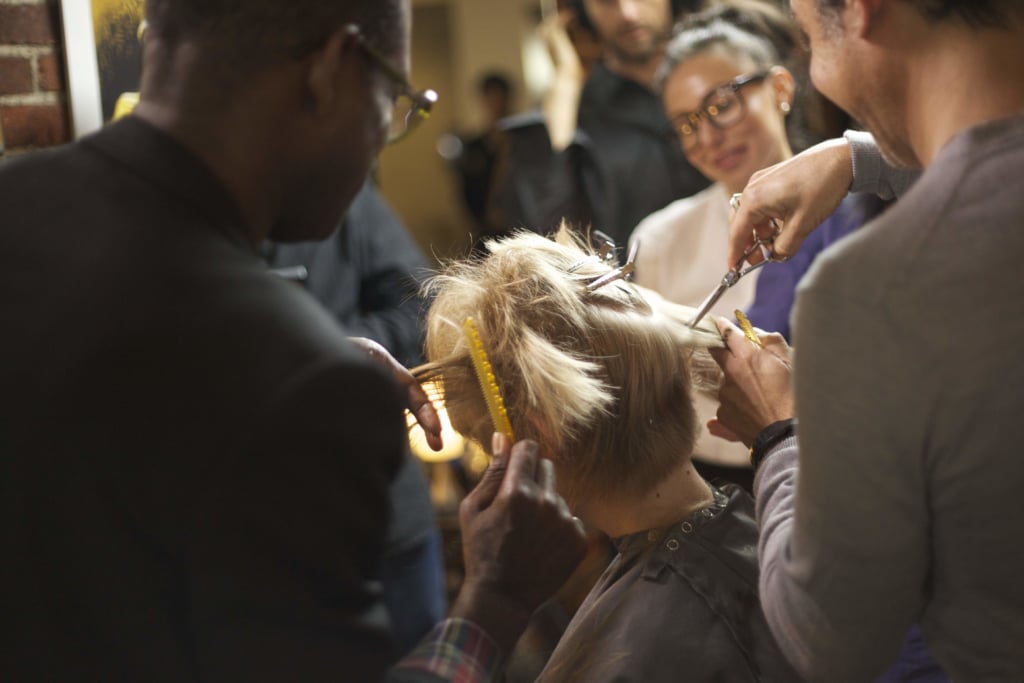Koki Tanaka, Theories of Behaviour Through Buckets
The artist draws on Japanese art history to develop a practice that is hyper contemporary, both in material and in matter.

‘A Haircut by 9 Hairdressers at Once (Second Attempt),’ 2010, Collaboration, video documentation (28 min), Zindagi Salon, San Francisco. Curator: Julio Cesar Morales, Commissioned by Yerba Buena Center for the Arts, San Francisco, Production photography: Tomo Saito,Participants: Victor A. Camarillo, Kristie Hansen, Nikki Mirsaeid, Olga Mybovalova, Sandra Osorio, Anthony Pullen, Brian Vu, Nicole Korth, Erik Webb, Karen Yee | photo courtesy of the artist, Vitamin Creative Space, Guangzhou and Aoyama Meguro, Tokyo
Artist Koki Tanaka works mainly with video, with many of his early works using a looping technique. Born in 1975, he is often described as an artist of his generation. Growing up through the fallout of the economic crash, his practice, down to his choice of materials, is conditioned by the social context within which he works. Many of his early pieces from the mid noughties would feature objects sourced from 100-yen stores. From these objects, he begins a critical investigation into perception and consciousness.
Many hands make light work
Later works, such as A Haircut by 9 Hairdressers at Once (2010), see the artist collaborate with teams of people, setting them to work on a single task as a collectivity. The piece unfolds as a sort of open-ended observed experiment, revealing the nature of routine behaviour and social relations between people. According to the artist speaking in an interview with Art It ‘the goal of the project is not to complete the task, per se, but rather to visualise the creative process.’
His practice may be acutely rooted in the contemporary, but he draws equally on the 1960s anti-art movement in Japan. Taking cues from the movement’s critical investigations into daily life, he scrutinises major events that are contemporary to him, including the 2011 tsunami and the ensuing Fukushima disaster. The anti-art movement provides just one reference among many for Koki Tanaka, whose practice is heavily influenced by Japanese post-war avant-garde art history, from Gutai to Mono-ha.
Whether the artist is staging himself in his video, performance, or installation work, as is characteristic of his early pieces, or calling upon the collaboration of others, a commitment to gesture remains, be it cutting hair, playing the piano, dropping buckets of water or hurling brooms. It is through these experimental and investigative processes that a reflection on community, society, and behaviour emerges.
A Haircut by 9 Hairdressers at Once (2010), an artwork by Koki Tanaka is available on his Vimeo channel.

‘A Haircut by 9 Hairdressers at Once (Second Attempt),’ 2010.
TRENDING
-
The Tradition of the Black Eggs of Mount Hakone
In the volcanic valley of Owakudani, curious looking black eggs with beneficial properties are cooked in the sulphurous waters.

-
Gashadokuro, the Legend of the Starving Skeleton
This mythical creature, with a thirst for blood and revenge, has been a fearsome presence in Japanese popular culture for centuries.

-
The Tattoos that Marked the Criminals of the Edo Period
Traditional tattoos were strong signifiers; murderers had head tattoos, while theft might result in an arm tattoo.

-
Colour Photos of Yakuza Tattoos from the Meiji Period
19th-century photographs have captured the usually hidden tattoos that covered the bodies of the members of Japanese organised crime gangs.

-
‘YUGEN’ at Art Fair Tokyo: Illumination through Obscurity
In this exhibition curated by Tara Londi, eight international artists gave their rendition of the fundamental Japanese aesthetic concept.





